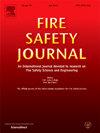Evaluation of the fall-off of gypsum board in lightweight and mass timber constructions and implications in fire resistance
IF 3.3
3区 工程技术
Q2 ENGINEERING, CIVIL
引用次数: 0
Abstract
This review study investigates the fall-off behavior of gypsum board (GB) in Lightweight Wood (LW) assemblies by synthesizing a comprehensive dataset compiled from previously conducted full-scale fire resistance tests. To address the inherent variability and scatter in the existing experimental data, this study incorporates detailed analyses and statistical modeling to discover consistent trends. A few quantitative findings are as follows: adding a second layer of 12.7 mm Type X GB increased the fall-off time to over 60 min, improving the fire resistance duration from an average of 50 min with a single layer to 68 min with 2 layers. On the other hand, insulated floors experienced accelerated GB degradation in 1-layer GB floors. Reducing the resilient channel spacing from 610 mm to 406 mm increased the fall-off time by approximately 10 % for 2-layer GB floors. In single-layer GB floors, the onset of wood charring was around 10.7 min before the GB fell off, while in two-layer GB floors, the charring began 6.4 min after the face layer's fall-off. These findings extend beyond LW systems, offering potential solutions for mass timber (MT) structures where practical and economical GB encapsulation can facilitate fire safety in such structures. This study evaluates the GB protection design equations in international codes showing that these equations are conservative for single-layer GB but within the average range of the experimental results.
轻质和大质量木结构中石膏板脱落的评价及其对防火性能的影响
本综述研究通过综合先前进行的全尺寸耐火测试汇编的综合数据集,调查了轻质木材(LW)组件中石膏板(GB)的脱落行为。为了解决现有实验数据的内在变异性和分散性,本研究结合了详细的分析和统计建模,以发现一致的趋势。定量结果如下:添加12.7 mm X GB类型的第二层,使脱落时间增加到60 min以上,耐火时间从单层平均50 min提高到2层平均68 min。另一方面,绝缘地板在单层GB地板中经历了加速的GB降解。将弹性通道间距从610毫米减少到406毫米,使2层GB地板的脱落时间增加了约10%。在单层GB地板中,木材在GB脱落前10.7 min左右开始炭化,而在双层GB地板中,木材在表层脱落后6.4 min开始炭化。这些发现超越了LW系统,为大质量木材(MT)结构提供了潜在的解决方案,其中实用和经济的GB封装可以促进此类结构的消防安全。本文对国际规范中GB防护设计方程进行了评价,结果表明,这些方程对于单层GB是保守的,但在试验结果的平均范围内。
本文章由计算机程序翻译,如有差异,请以英文原文为准。
求助全文
约1分钟内获得全文
求助全文
来源期刊

Fire Safety Journal
工程技术-材料科学:综合
CiteScore
5.70
自引率
9.70%
发文量
153
审稿时长
60 days
期刊介绍:
Fire Safety Journal is the leading publication dealing with all aspects of fire safety engineering. Its scope is purposefully wide, as it is deemed important to encourage papers from all sources within this multidisciplinary subject, thus providing a forum for its further development as a distinct engineering discipline. This is an essential step towards gaining a status equal to that enjoyed by the other engineering disciplines.
 求助内容:
求助内容: 应助结果提醒方式:
应助结果提醒方式:


